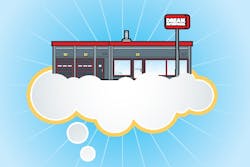Shop Owners’ Dream Choices
What is “ultimate?” according to web-ster’s dictionary, ultimate means “highest; representing a limit beyond which further progress is impossible; the greatest.”
But whose ultimate are we talking about? After surveying several longtime collision repair shop owners and industry experts about what they’d choose for an ideal start-up if money were no object, FenderBender found that opinions vary on what would constitute the ultimate in the eight shop areas we asked our respondents to focus on: frame machines, prep stations, estimating systems, mechanicals, paint booths, measuring systems, welding and air compressors.
Why are those areas so important? According to Mike Anderson, a national collision repair consultant and owner of Wagonwork Collision Centers in Alexandria, Va., “These are crucial areas to make shop procedures cost-effective, faster, better, more lean, in an effort to minimize mistakes.”
We also found out that while, as expected, state-of-the-art products and equipment were emphasized by many of our respondents, most also pointed out that often, it’s not so much a matter of what is used in a shop as it is a matter of how it’s used. Anderson, for example, noted that even with the best equipment, “shops need to be laid out well, with effective space utilization to remove bottlenecks.”
As an example, Anderson specifically favored streamlining parts installation methods to reduce repair cycle time by using racecar production processes. Along these lines, long benches would be set up on both sides of vehicles being repaired so old and new parts can be put on the benches simultaneously — speeding up the process without sacrificing quality. Anderson also favored bigger parts areas, well lit facilities and white paint on the walls.
Anderson’s 42 years in the business further prompted him to remind our readers that while cost-consciousness would be paramount in any ultimate shop, cheaper is not always better, especially when it comes to equipment. “You get what you pay for,” he noted.
Meanwhile, one of the shop owners surveyed for this story said he’s already achieved what he considers his “ultimate shop.” He invested $800,000 - $900,000 in his business 12 years ago to create more efficiency and free up bottlenecks in places like the paint shop, prep areas and the body shop. The investment, said the shop owner, who has logged more than 35 years in the collision repair business, “definitely has increased the bottom line. In fact, it made an immediate difference not long after these changes were made.”
Finally, most shops contacted agreed that technician training and safety should also be key elements of any discussion about the ultimate shop, with all technicians mask- and fit-tested every six months, for example.
With these things in mind, a composite ultimate body shop follows, built around our shop owners’ preferences and summary descriptions in each product and equipment category. Opinions on customer service, business training and marketing trends round out our shop owners’ ultimate-shop wish list.
CUSTOMER SERVICE AND ‘ULTIMATE’
Because of fierce competition, a shrinking market, technician shortages and insurance industry pressures, it will also become more important to give the ultimate in customer service, most of our shop-owner sources agreed.
Anderson, for example, recommended making rental fleets available, not just free loaners on an as-needed basis. Sam Carubba, of Sam Carubba Auto Vision Collision Center in East Amherst, N.Y., meanwhile, predicted an industry-wide customer-service “paradigm shift” over the next five years, creating a constant need to train and retrain employees, including a shop’s administrative staff. Carubba already sends his employees to Dale Carnegie human relations classes each year, for example, while Barrett Smith, of Brandon Paint & Body, Brandon, Fla., has made his shop appear more like a doctor’s office, elevating his business’s “corporate culture,” as well as its community image. Another industry expert recommended bringing the customer closer to the repair process — by installing windows in estimating areas near the paint booth, for example, allowing customers to actually see their freshly painted vehicles roll out.
Over the next five years, the insurance industry could also become an even greater driving force on customer service, our sources said, increasing the pressure to reduce cycle times and create standard operating procedures to repair vehicles, handle customers, provide rentals and increase service value while boosting efficiency. So getting educational help from manufacturers and other sources will also likely be a key component of the future’s ultimate shop.
In addition, shop owners will need to do more to market themselves, with many industry sources seeing shops joining forces on advertising, public relations events, etc.
According to the U.S. Department of Transportation, there are twice as many female as male licensed drivers in America today, so many sources said there should be more women shop employees — to handle claims, for example, since females tend to visit shops more often for estimates after an accident.
